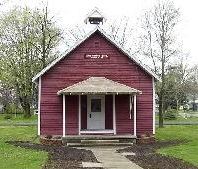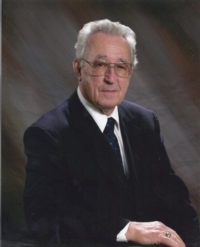 On the wall of my office hangs one of my most cherished possessions. It is old and yellowed with age, but it is a delight to look at with its artistic embellishments and its beautiful calligraphy. It has a beautiful wood cut print of a lyre, a bust, a globe and various other implements of knowledge under an arched graphic proclamation, Washington County Indiana Public Schools. It measures a prominent size of 22 inches long and 17 inches high. It certifies that, Bertha Susan Roll of Posey Township, Washington County, Indiana has passed a creditable examination in Orthography, Reading, Writing, Arithmetic, Geography, English Grammar, Physiology, and United States History. It is signed by Joe C. Bush, County Superintendent and dated the 23rd day of August 1900. In the lower left corner is an affixed gold seal of the Indiana State Department of Education. That class of Posey Township had seven graduating seniors and represented the handful of residents in that rural county who would ever achieve a high school education.
On the wall of my office hangs one of my most cherished possessions. It is old and yellowed with age, but it is a delight to look at with its artistic embellishments and its beautiful calligraphy. It has a beautiful wood cut print of a lyre, a bust, a globe and various other implements of knowledge under an arched graphic proclamation, Washington County Indiana Public Schools. It measures a prominent size of 22 inches long and 17 inches high. It certifies that, Bertha Susan Roll of Posey Township, Washington County, Indiana has passed a creditable examination in Orthography, Reading, Writing, Arithmetic, Geography, English Grammar, Physiology, and United States History. It is signed by Joe C. Bush, County Superintendent and dated the 23rd day of August 1900. In the lower left corner is an affixed gold seal of the Indiana State Department of Education. That class of Posey Township had seven graduating seniors and represented the handful of residents in that rural county who would ever achieve a high school education.
Today it would be laughable. Today its 117 years old but of inestimable value because of its stature and cartography. It’s a relic of a bygone era when we took pride in educating our youth. It represents the pride and commitment which early pioneers, placed on their educational system. It represents the quality and quantity of knowledge which children learned using chalk and a slate board. It was the prized possession of my grandmother, a pioneer woman with a clear, steady will-power, powerful vision and highly developed, thinking skills. We lost those capabilities as the 20th century progressed and society began to form the mold of one size fits all!
Beside it are my two college degrees. They measure a standard 8 1/2 by 11 and plainly printed in standard print. A tiny printed seal of the University in standard black ink is placed in the middle of the bottom. It has six signatures signifying nothing but pomposity and authority. These two documents were issued in 1950 and 1955. We were into the “baby boomer” age of post war America and babies were being raised by the millions using the sage philosophy and advice of Dr. Benjamin Spock. We had entered the age of permissiveness and already the sacred duties of educating our young had been relegated to a production line status where the kid was fed in one end, carefully guided through a prescribed and canned curriculum and dumped out the other as the education system fought valiantly to keep its head above water with the dilemma of how to accommodate and train those millions of new children in the pipeline. Into this confusing and frantic America,
I began my teaching career on the Zuni Indian Reservation, 42 miles from everywhere in the wilds of the Zuni mountains of northwest New Mexico. The only modern conveniences we had were indoor plumbing and electricity. There were no telephones, no television, no restaurants or movies. We had one clear and powerful radio station coming from Window Rock, Arizona but it was Navajo owned and practically all verbal language was spoken in Navajo.
The only part it had for us was that they played country music. I taught the sixth grade of 27 Zuni children ranging from 11 to 16 years old. I was the basketball, baseball and track coach. Sometimes these children were not found and put in school by the principal until they were 10 and 11 years old. At least 90% of them could not speak a word of English when they started school but by the time they got to me they were speaking excellent English and functioning well with English textbooks. The philosophy was that we would encourage them to continue using their native language after school hours but for eight hours a day they were not permitted to use anything but English. Today across America, districts with foreign speaking children have developed many varieties of “English as a second language” programs which end up being taught by teachers with abilities to speak both languages but spend most of their class time using the second language which just delays learning English.
Due to the increase of political and social correctness, we have managed to water down and weaken our curriculum to a weak Pablum of mediocrity. In our everyday life we have allowed the philosophy of quantity over quality and cheap over durable, to permeate every corner of our lives. We have lost our sense of pride for the sake of quick and convenient. It is a sad day in America as our elected leaders struggle to find out what’s wrong when the problems are so glaringly obvious.
We have abandoned the writing, orthography, physiology, and combined the geography and history into a sorry collection of almost nothing called Social Studies. It is neither geography nor history but concerns itself with social interactions. Some schools claim to teach a modicum of history but closer examination of the content makes that claim laughable. With the latest burden of the Federally mandated, standardized curriculum called “Core Curriculum” we have taken the final step to creating a nation of small puppets, all trained to think act and respond in identical fashion. We have made the fatal error of creating a “one size fits all” philosophy which is sick and dreadfully wrong.
I spent 30 years in the publishing field and learned how the textbooks are really created and produced, which are being used in today’s American school. In my next dispatch I intend to tell America exactly what their children are being given to learn from and how it is actually created. It’s the taxpayer’s money which is being wasted on less than mediocre products.
January 25, 2017
 ~ The Author ~
~ The Author ~
Frank Newby has a 60 year background in education. He has a Master’s Degree in Educational Administration. During a long career, he has taught grades K-12, been a principal and sold textbooks to the schools for 30 years. He was a pioneer in the introduction of computers into the schools. He has called on a majority of the school systems in the inter-mountain West and done numerous guest lectures in western colleges. In retirement he spent three years substitute teaching to experience the conditions of the secondary schools. He is the author of many books and a life long researcher. His pastimes include painting, woodworking, gardening and writing.
